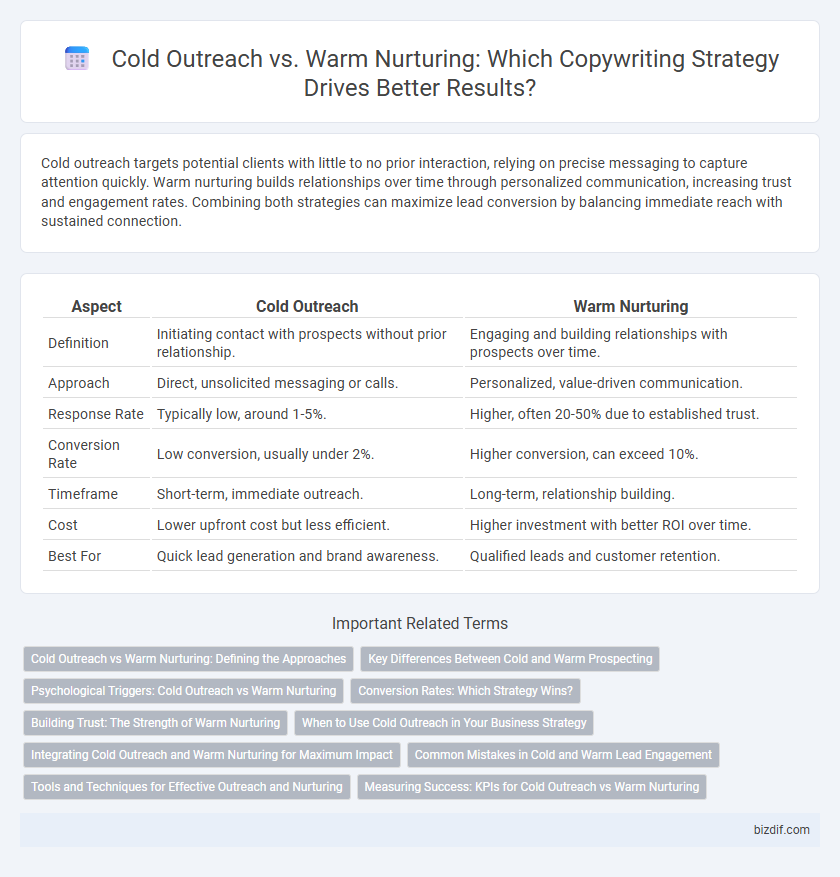Cold outreach targets potential clients with little to no prior interaction, relying on precise messaging to capture attention quickly. Warm nurturing builds relationships over time through personalized communication, increasing trust and engagement rates. Combining both strategies can maximize lead conversion by balancing immediate reach with sustained connection.
Table of Comparison
| Aspect | Cold Outreach | Warm Nurturing |
|---|---|---|
| Definition | Initiating contact with prospects without prior relationship. | Engaging and building relationships with prospects over time. |
| Approach | Direct, unsolicited messaging or calls. | Personalized, value-driven communication. |
| Response Rate | Typically low, around 1-5%. | Higher, often 20-50% due to established trust. |
| Conversion Rate | Low conversion, usually under 2%. | Higher conversion, can exceed 10%. |
| Timeframe | Short-term, immediate outreach. | Long-term, relationship building. |
| Cost | Lower upfront cost but less efficient. | Higher investment with better ROI over time. |
| Best For | Quick lead generation and brand awareness. | Qualified leads and customer retention. |
Cold Outreach vs Warm Nurturing: Defining the Approaches
Cold outreach targets potential clients with no prior relationship, relying on clear, compelling messaging to capture attention quickly. Warm nurturing involves engaging leads who have shown interest, using personalized content to build trust and encourage conversion over time. Both strategies require tailored communication but differ fundamentally in their starting point and relationship depth.
Key Differences Between Cold and Warm Prospecting
Cold outreach involves contacting potential customers with no prior relationship, often resulting in lower response rates and higher rejection due to lack of familiarity. Warm nurturing targets prospects who have already engaged with your brand, leveraging established trust and interest to boost conversion rates. The key difference lies in the level of relationship and engagement, where warm nurturing fosters ongoing communication while cold outreach aims to initiate first contact.
Psychological Triggers: Cold Outreach vs Warm Nurturing
Cold outreach leverages psychological triggers like curiosity and urgency to capture immediate attention and prompt quick responses, often relying on scarcity and social proof. Warm nurturing, on the other hand, uses trust-building triggers such as reciprocity and consistency to deepen relationships over time, fostering brand loyalty and higher conversion rates. Understanding the contrasting impact of these triggers helps tailor messaging strategies for more effective engagement in copywriting.
Conversion Rates: Which Strategy Wins?
Cold outreach often results in lower conversion rates due to lack of prior relationship, averaging around 1-3% success. Warm nurturing leverages established trust and engagement, boosting conversion rates significantly, often reaching 15-30%. Data-driven strategies show that personalized follow-up sequences in warm nurturing outperform generic cold outreach campaigns in both lead quality and sales closure.
Building Trust: The Strength of Warm Nurturing
Warm nurturing builds trust by fostering genuine relationships through personalized communication and consistent engagement, leading to higher conversion rates. Unlike cold outreach, which often feels intrusive and impersonal, warm nurturing leverages existing connections and tailored content to enhance credibility and rapport. This trust foundation increases customer loyalty and long-term business growth, making warm nurturing a more effective strategy in copywriting.
When to Use Cold Outreach in Your Business Strategy
Cold outreach is ideal for expanding your customer base by targeting new audiences who are not yet familiar with your brand, making it essential during the initial stages of market expansion or launching new products. Implement cold outreach campaigns when your goal is to generate leads quickly and establish early contact in untapped markets, focusing on personalized messaging that addresses potential clients' pain points. This strategy complements warm nurturing by creating initial awareness and interest, which can later be cultivated through relationship-building efforts.
Integrating Cold Outreach and Warm Nurturing for Maximum Impact
Integrating cold outreach with warm nurturing maximizes engagement by combining the efficiency of initial contact with the personalized approach of relationship building. Data shows that follow-up nurturing increases conversion rates by up to 70% compared to cold outreach alone. Utilizing automated sequences for cold outreach alongside targeted content in warm nurturing creates a seamless customer journey that boosts brand trust and sales.
Common Mistakes in Cold and Warm Lead Engagement
Cold outreach often suffers from generic messaging that fails to personalize content for the recipient, leading to low response rates and disengagement. Warm nurturing can be undermined by inconsistent follow-ups and lack of value-added communication, causing prospects to lose interest over time. Effective lead engagement requires tailored approaches that balance persistence with relevance, avoiding the pitfalls of automation and impersonal outreach.
Tools and Techniques for Effective Outreach and Nurturing
Cold outreach relies on tools like email automation platforms, LinkedIn prospecting software, and CRM systems to identify and contact potential leads efficiently. Warm nurturing emphasizes personalized content delivery, marketing automation tools such as HubSpot or Marketo, and behavioral tracking to engage and build long-term relationships. Combining data-driven analytics with segmentation techniques enhances both outreach methods by targeting the right audience with tailored messaging.
Measuring Success: KPIs for Cold Outreach vs Warm Nurturing
Key performance indicators (KPIs) for cold outreach include response rate, conversion rate, and cost per lead, which directly measure initial engagement and campaign efficiency. Warm nurturing KPIs focus on lead velocity rate, customer lifetime value, and retention rates to assess relationship building and long-term revenue growth. Tracking these metrics enables marketers to optimize strategies by understanding the distinct impact of cold versus warm approaches on sales funnel progression.
Cold Outreach vs Warm Nurturing Infographic

 bizdif.com
bizdif.com